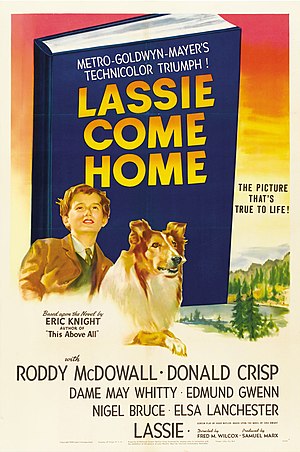Lassie Come Home
Jump to navigation
Jump to search
| This article was copied (instead of imported) from the now-deleted Miraheze wikis. |
| Lassie Come Home | ||||||||||||||||||||||||||
|---|---|---|---|---|---|---|---|---|---|---|---|---|---|---|---|---|---|---|---|---|---|---|---|---|---|---|
This film has been preserved in the National Film Registry in 1993.
| ||||||||||||||||||||||||||
 | ||||||||||||||||||||||||||
|
Lassie Come Home is a 1943 Metro-Goldwyn-Mayer Technicolor feature film starring Roddy McDowall and canine actor Pal, in a story about the profound bond between Yorkshire boy Joe Carraclough and his rough collie, Lassie. The film was directed by Fred M. Wilcox from a screenplay by Hugo Butler based upon the 1940 novel Lassie Come-Home by Eric Knight. The film was the first in a series of seven MGM films starring "Lassie."
Why It Rocks
- Like the short story and novel the film's based on, the film draws heavily on Eric Knight's childhood, not only in its portrayal of the Yorkshire landscape, but in terms of the guarded interaction between the upper and lower classes.
- The overall story is told with enough poignance and simple beauty and is overall a heartwarming tale between a dog undying loyalty to his owner.
- Incredible acting from the majority of the cast, including Roddy McDowall and Donald Crisp, which have starred alongside each other in a previous film. Then the majority of the supporting cast is taken up by long-time professionals who really give off some memorable performances, including Dame May Whitty, Edmund Gwenn, Nigel Bruce, and especially Pal the dog who "plays" the iconic Lassie.
- The one major newcomer was Elizabeth Taylor as the Duke's granddaughter.
- Gorgeous and unforgettable soundtrack with amazing orchestration.
- As the film covers a dog's 400-mile journey from Northern Scotland to Greenall Bridge in Yorkshire, its plot is closely tied to a landscape of highlands, lochs and moors. And although the scenes were shot in California rather than Great Britain like in the novel, the locations shot approximated the novel's settings enough and the scenery looked absolutely beautiful. The first-rate production values and color photography are on full display here.
- Even though it's a children's story, the work in question (both the novel and the film) isn't afraid to get into some dark and/or serious themes as it sends a shocking amount of time on unemployment, class friction, brutality and death.
The Only Bad Quality
- The film stints on a few of the novel's scenes (probably for budget-related reasons) and includes moments that may be confusing for people who didn't read the book, such as armed shepherds who consider shooting the dog as it crosses a field. Even a lot of the class-conscious dialogue is taken straight from the book.